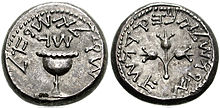- First Jewish Revolt coinage
-
 A coin issued by the Jewish rebels in 68 AD, note Paleo-Hebrew alphabet. Obverse: "Shekel, Israel. Year 3". Reverse: "Jerusalem the Holy"
A coin issued by the Jewish rebels in 68 AD, note Paleo-Hebrew alphabet. Obverse: "Shekel, Israel. Year 3". Reverse: "Jerusalem the Holy"
 Bronze prutah eighth of a shekel (69–70 AD) issued during the First Jewish Revolt
Bronze prutah eighth of a shekel (69–70 AD) issued during the First Jewish Revolt
First Jewish Revolt coinage was issued by the Jews after the Zealots captured Jerusalem and the Jewish temple from the Romans in 66 AD at the beginning of the First Jewish Revolt. The Jewish leaders of the revolt minted their own coins to emphasise their newly obtained independence from Rome.
In the revolt's first year (66–67 AD), the Jews minted only silver coins, which were struck from the temple’s store of silver. These coins replaced the Tyrian shekel, which had previously been used to pay the temple tax. The newly-minted silver coins included shekels, half-shekels, and quarter-shekels, each being labelled with the year of minting and their denomination. These are the first truly Jewish silver coins,[1] and depict a chalice on the obverse with the year of the revolt above, surrounded by the ancient Hebrew inscription "Shekel of Israel". Three budding pomegranates are featured on the reverse, with the inscription "Jerusalem the Holy".[2]
During the second (67–68 AD) and third (69–70 AD) years of the revolt bronze prutah coins were issued, depicting an amphora, and with the date and the Hebrew inscription "The Deliverance of Zion".
In the fourth year of the revolt (70–71 AD) three large sizes of bronze coins were minted, possibly because the supplies of Temple silver were diminishing. It is believed by numismatists that these coins were fractions of a shekel. The smaller of these coins also has the depiction of a chalice, together with symbols of the Jewish harvest festival of Sukkot, a lulav and etrog, and the date and inscription "For the Redemption of Zion". This coin is usually called an 'eighth', probably being an eighth of a shekel.
The medium size coin has the same inscription, with the denomination "reva" (quarter) inscribed. An etrog is depicted on the obverse, and two lulav are on the reverse. The larger of the three bronze coins are inscribed "chatzi" (half). On the obverse a lulav and etrog are again depicted, with a palm tree and baskets on the reverse.[2] These coins are sometimes referred to as 'Masada coins'.
See also
References
External links
Categories:- Numismatics
- Currency lists
- Jewish history
- Jews and Judaism in the Roman Empire
- Ancient currencies
- Hebrew inscriptions
Wikimedia Foundation. 2010.
